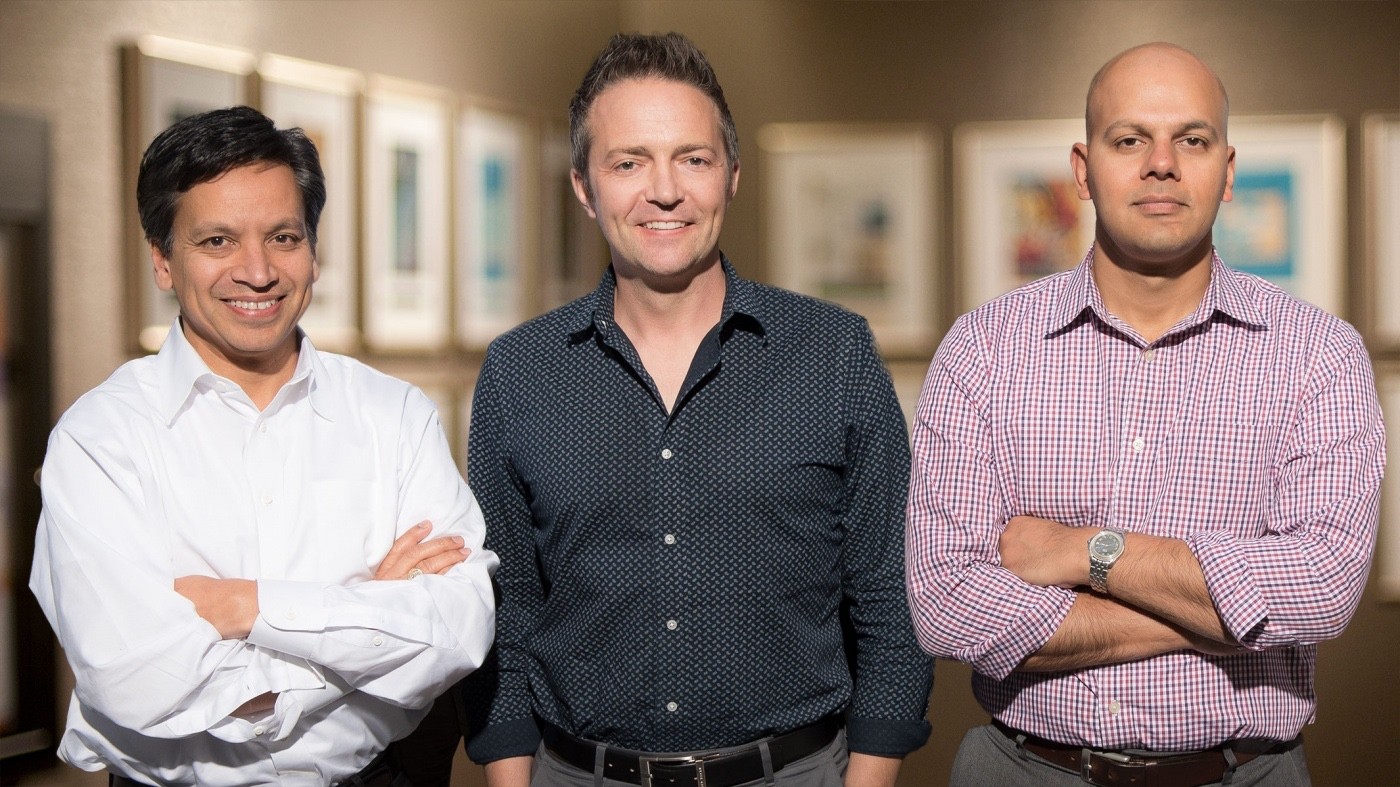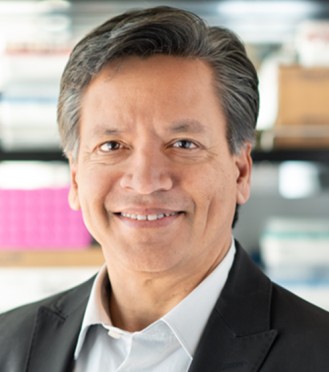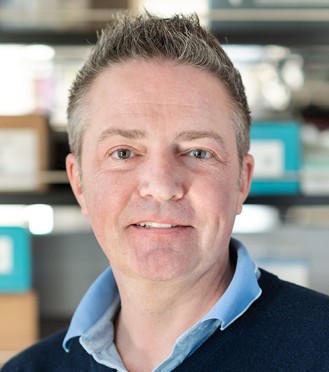Gladstone NOW: The Campaign Join Us on the Journey✕

Deepak Srivastava, MD (left), Benoit Bruneau, PhD (middle), and Saptarsi Haldar, MD (right), are studying the basic biology of the heart to guide the discovery of new therapies.
From grandparents to grandchildren, patients with heart disease will benefit from cardiovascular research at the Gladstone Institutes. A trio of Gladstone scientists are studying the basic biology of the heart to guide the discovery of new therapies for conditions such as congenital heart disease and heart failure.
Fixing Holes in the Heart
Developmental biologist Benoit Bruneau, PhD, believes that, to heal the heart, you must understand the organ’s origin. He studies the biological signals that shape heart development in an embryo, and discoveries made by his laboratory may lead to better ways to heal or even prevent holes in the hearts of infants, the most common birth defect.
Bruneau’s research revealed that, from the start, cells in the heart are designated for a specific purpose and location. For example, cells in the left ventricle, the chamber of the heart that pumps blood to the body, are destined to serve that purpose within the first few days of development in an embryo. However, in babies with heart defects, these cells get confused and wind up in the wrong place. For example, in children who are born with septal defects—a hole in the wall between the left and right chambers of the heart—cells from the left and right ventricle inter-mix during the earliest stage of formation, breaching the critical wall between the two sections.
This type of congenital heart defect can be caused by a mutation in the gene TBX5, which is one of the genes essential for heart development. TBX5 produces a protein of the same name that acts as a critical switch, helping to turn other genes involved in heart development on or off. When TBX5 is mutated, it does not produce enough of the TBX5 protein, which in turn affects the other genes and proteins in the heart.
Bruneau’s team is now researching the precise changes in gene expression and protein levels caused by a mutation in TBX5. “We’ve known for a while that mutations in TBX5 result in different types of heart disease, but how these mutations result in disease has largely remained a mystery,” said Bruneau, who is the associate director of the Gladstone Institute of Cardiovascular Disease. “We hope to shed light in this black box to reveal how the genes affect the cells’ identity and behavior.”
Regenerating Damaged Hearts
TBX5 has another significance for heart researchers: it is one of the three crucial factors that can transform a scar-forming cell in the heart into a beating heart muscle cell.
Deepak Srivastava, MD, a pediatric cardiologist and director of the Gladstone Institute of Cardiovascular Disease, pioneered this type of cardiac cellular reprogramming research. His laboratory discovered the cocktail of factors, including TBX5, that change a cell’s identity and coax it into becoming a heart cell. One of TBX5’s key partners for cardiac reprogramming, GATA4, is also essential for heart formation and causes septal defects in children when mutated. These factors work together to activate genes involved in fashioning heart muscle cells, while suppressing genes characteristic of other cell types.
Srivastava is using cellular reprogramming to treat heart failure and replace dead cells after a heart attack. He showed that, when the factors are injected into a damaged mouse heart, they convert scar tissue into healthy beating muscle cells, improving heart function. Now, Srivastava is testing this revolutionary technology in pigs—larger animals with hearts that more closely resemble humans.
“Although we have drugs that can temporarily improve heart function, the only current cure for heart failure is a heart transplant,” said Srivastava. “The most encouraging aspect of our cellular reprogramming approach is that it may permanently restore heart function. If this type of regenerative medicine works in humans, it could completely change how we treat heart disease in the future.”
Blocking the Heart’s Harmful Changes
Adult cardiologist Saptarsi Haldar, MD, is attempting to treat heart disease by influencing genes in a different way. Haldar’s laboratory studies the genetic changes that occur in aging and diseased heart cells in the hope of finding new treatments to improve heart function.
When heart cells get overly stressed, as can occur with high blood pressure or after a heart attack, the same proteins that are involved in heart development go into a state of overdrive, inappropriately turning a host of genes on and off. If left unchecked, these changes in gene expression cause the heart to become enlarged, inflamed, and full of scar tissue. As a result, the organ stops functioning properly, eventually leading to poor pumping function and heart failure.
“When the heart is in the process of forming in the embryo, proteins such as TBX5 and GATA4 function like switches to turn genes involved in heart development on or off,” explained Haldar, who is an associate investigator at Gladstone. “However, once you’re an adult and the heart is completely formed and mature, these same switches can be inappropriately reactivated by stress, and if they are turned on too long, they can remodel the heart in a bad way.”
Haldar discovered that stress triggers the activity of another important family of cardiac proteins called BET bromodomains. These proteins work in concert with “switch” proteins such as TBX5 and GATA4 to amplify their effect on gene expression. While it is extremely difficult to target proteins like TBX5 and GATA4 with a drug, BET bromodomains can be targeted safely. Haldar identified a drug that inhibits these proteins and returns their activity levels to normal, blocking the harmful changes in cardiac gene expression and halting the progression of heart damage.
Basic Science, Big Discoveries
By studying both the embryonic formation and adult function of the heart, Gladstone scientists are making new inroads in their understanding of cardiac health and disease. Through close collaboration, they are leveraging their knowledge of the basic biology of the heart to reveal common themes. For example, the important role of proteins like TBX5 in cardiac development in embryos and heart failure in adults. This work has helped them identify new drug targets and novel treatment methods, taking them one step closer to their ultimate goal: curing heart disease in patients of all ages.
Support Discovery Science
Your gift to Gladstone will allow our researchers to pursue high-quality science, focus on disease, and train the next generation of scientific thought leaders.
Matters of the Heart: A Conversation with Gladstone’s Benoit Bruneau
Matters of the Heart: A Conversation with Gladstone’s Benoit Bruneau
Bruneau, director of the Gladstone Institute of Cardiovascular Disease, shares exciting recent advances in heart research and talks about the impact of predictive AI.
Gladstone Experts Heart Failure Cardiovascular Disease Alexanian Lab Bruneau Lab Pollard Lab Theodoris Lab AIGladstone Researchers Discover How Chronic Inflammation Worsens Heart Failure
Gladstone Researchers Discover How Chronic Inflammation Worsens Heart Failure
The new findings have implications for developing immune therapies that target heart disease and chronic conditions in other organs.
News Release Research (Publication) Heart Failure Cardiovascular Disease Alexanian Lab Srivastava LabGladstone’s Catherine Tcheandjieu Gueliatcha Named an ‘Emerging Leader’ by National Academy of Medicine
Gladstone’s Catherine Tcheandjieu Gueliatcha Named an ‘Emerging Leader’ by National Academy of Medicine
Tcheandjieu is one of 10 scholars nationwide selected as an emerging leader who's shaping the future of health and medicine.
Awards News Release Heart Failure Data Science and Biotechnology Tcheandjieu Lab AI Big Data





